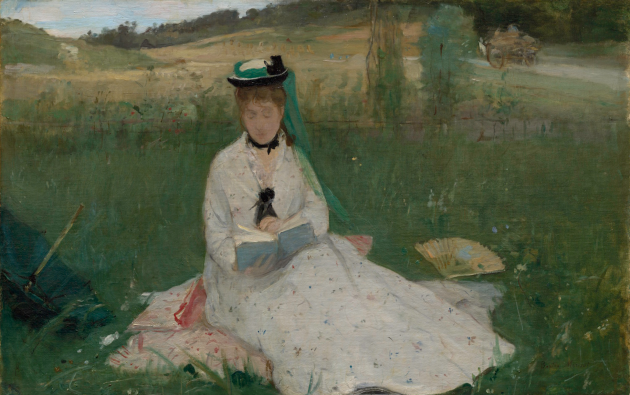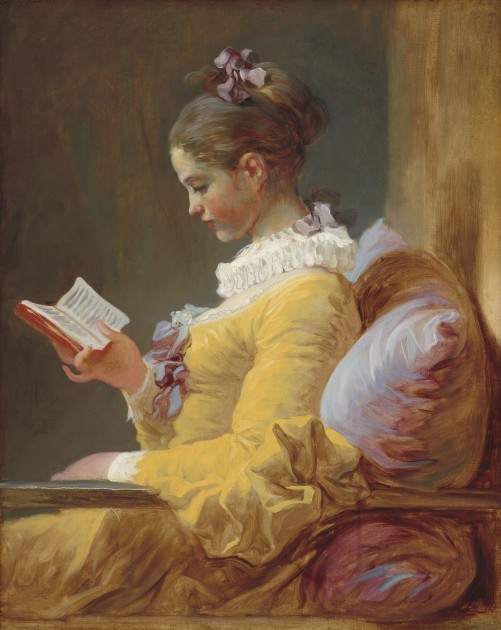Monday, April 15th, 2019
Fragonard and Morisot?

Berthe Morisot, “Reading (The Green Umbrella), 1873. Oil on fabric, 18 1/8 × 28 1/4 in. (46 × 71.8 cm). Cleveland Museum of Art
The post that you are reading is a very different one than the first one that I originally wrote this evening. I recently read in The Art of Reading: An Illustrated History of Books in Paint that Berthe Morisot was the descendant of the painter Jean-Honore Fragonard, and I hoped to write a post that explored that relationship between the two. However, as I researched, I found conflicting information about how Morisot was either the granddaughter of Fragonard, the great-niece of Fragonard, or the great-great-niece of Fragonard. So I began to comb through the genealogical timelines of the Morisot family and realized that I couldn’t find a clear ancestral connection between the artists at all. Dozens of sources claim that this connection comes through the family of Berthe’s mother, who was named Marie-Joséphine-Cornélie Thomas, although as of yet I can’t find the origin of this claim in writing. I can assert though, that Morisot is not the granddaughter of Fragonard: her paternal grandparents were Tiburce Pierre Morisot and Claude Elisabeth Morisot; her maternal grandparents were Jean Simon Joseph Thomas and Caroline Françoise Marie Mayniel.
Chronologically, it seems to be that Fragonard lived four generations before Morisot. Her only two great-grandparents that I know of (her grandmother’s parents, whose names were Jean Henri Mayniel and Josephine Anne Victoire de Ménard) were both born in 1760. That doesn’t go back far enough to meet up with Fragonard, who was born in 1732. Other branches of Berthe Morisot’s family line don’t seem to go back far enough, at least through online genealogical records. I finally found an archived excerpt of Anne Higgonet’s 1995 book Berthe Morisot, which explains that “family tradition claims indirect descent from the painter Fragonard.” Is this actually just a “family tradition” then, but an unsubstantiated one? If that’s the case, we need to stop repeating it in scholarship or take Higgonet’s approach to explain the relationship has just been merely “claimed” or rumored through family tradition.
I can see how it is appealing to connect these two artists together. Fragonard painted many outdoor scenes that depicted aristocrats engaged in romantic or pleasurable pursuits. Likewise, Morisot painted plein air and often depicted members of the bourgeoisie. I also like thinking about how they both were drawn to the subject matter of a woman reading: Fragonard’s Woman Reading (c. 1776, shown below) was made almost exactly one hundred years before Morisot’s Reading (The Green Umbrella) from 1873 (shown above). It is also clear to see how Fragonard’s lively brushwork (especially seen in the fabric of the painting) helps to open the door for the loose, painterly strokes of the Impressionists like Morisot.
One thing is certain: if Morisot was a descendant of Fragonard, she never met the artist. Fragonard died in 1806 and Morisot was born in 1841. The one thing that makes the ancestral connection believable in some regard is that Fragonard’s reputation and career fell into a decline during the end of his lifetime due to the upheaval of the French Revolution.1 He even remained relatively unknown for the first half of the 19th century and was even omitted from scholarship.2 So he would have seemed like an odd choice to claim kinship in the 19th century, unless the kinship either was actual or derived from family lore that began in the 18th century!
If you can fill in the genealogical record or add to the connection (or lack thereof) between Fragonard and Morisot, please share! I’m also curious to learn how this “family tradition” has been upheld in scholarship – who was the first to pen down this connection? Was it Berthe Morisot herself or it is in an Impressionist review? So far the earliest mention I have found is from 1904.
Regardless of the ancestral connection, I am particularly struck at how often this connection has been repeated in scholarship and publications. On one hand, it is a neat connection if it is true, simply to show how art was a familial pursuit. But I also wonder if this connection to Fragonard was also used to legitimize the contributions of a female artist in the male-dominated world of art.
1 Melissa Percival, Fragonard and the Fantasy Figure: Painting the Imagination (Routledge, 2017), p. 19. Found online here: https://books.google.com/books?id=lCgxDwAAQBAJ&lpg=PP19&ots=Ao2piIFUCW&dq=fragonard%20posthumous%20reputation&pg=PP19#v=onepage&q&f=false
2 Ibid.

I’ve never run across this claim, not that I’ve done a lot of research into Morisot. It does sound fanciful, though. It might be interesting to look at Morisot’s letters and see if she was aware of the family rumor and if it influenced her work
Love your blogue and this post was very interesting, as usual. The connection between Fragonard’s and Morisot’s painting is very interesting, even if they weren’t related.
Hey, I just wanted to thank you for making this post! I’m doing a research paper on Berthe Morisot, so I’ve been reading about her life from multiple sources. Like you mentioned in your post, one source said she was the granddaughter of Fragonard, and another said she was a distant relative. I decided to go searching, and I found your blog. Thank you so much for clearing this up for me!
From what I’ve read, the rumor is derived from an alleged portrait of Claudine Elisabeth Duchesne (Berthe’s paternal grandmother) by Fragonard’s son Alexandre-Evariste Fragonard and the fact that the two families both came from the region of Grasse and both made careers on commissioned works ( the Morisot’s were architects) in the court of the ancien regime. If there is a connection, my tentative hypothesis is that there is an illegitimate affair somewhere in the mix. This is substantiated by the fact it is assumed Josephin Morisot was Berthe’s grandfather but he is not listed on her father’s birth certificate and is actually likely her great uncle. Furthermore, in Berthe’s correspondence, it is her mother’s side the Mayniel’s and the Thomas’s that feature the most, relatives on her father’s side are hardly mentioned. The biographer Margeret Sheehan puts forward the claim that the Fragonard link might be via the Manet side through Manet’s mother Eugenie Fournier because of the striking coincidence of Alexandre-Evariste Fragonard wife Julie Fournier, maybe Julie’s namesake? (That being said Fournier is a pretty common last name in France so I’m not very convinced ). Julie ( Berthe’s daughter) became the keeper of all things Berthe Morisot and the go-to for biographers after her mother’s death, so perhaps her mother mentioned it in passing, that she might be the descendant of Fragonard, and the young Julie took it as truth. And it’s not surprising Berthe Morisot would look to the past for explanations of her passion for painting, her family seemed to think her talent was just a rare, unique outburst and perhaps she found this mythology of Fragonard and the female artists in his circle, like Marguerite Gérard, as her relatives comforting.
Hi Bess! Thanks for sharing this information! I can’t find any information online about Claudine Elisabeth Duchesne or this alleged portrait, but I will keep digging elsewhere and follow this lead. I assume that this alleged portrait is thought to be lost?
I believe I saw it in the catalog released for the Musee d’Orsay exhibition in 2019, however, I may be mistaken as I don’t own the book. Good Luck. As Morisot writes, “so many mute dead behind us, who lived, ate, drank and slept, leaving nothing behind to help their children to understand,” the Fragnonard link may remain a mystery.